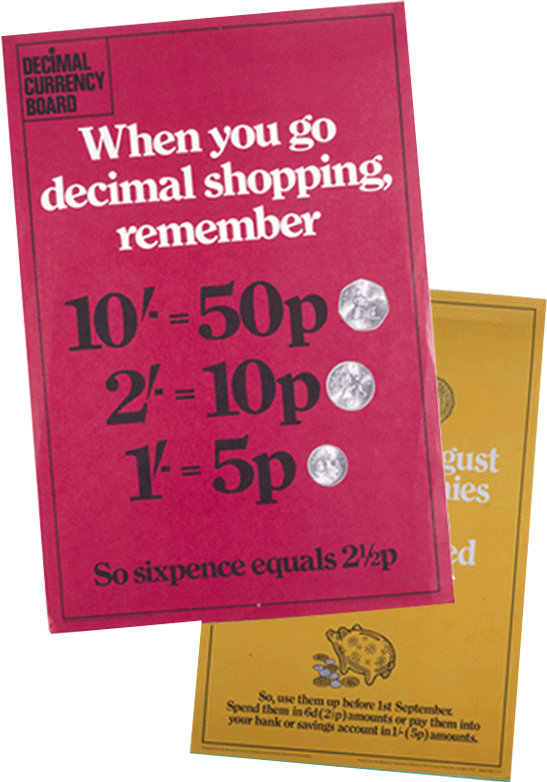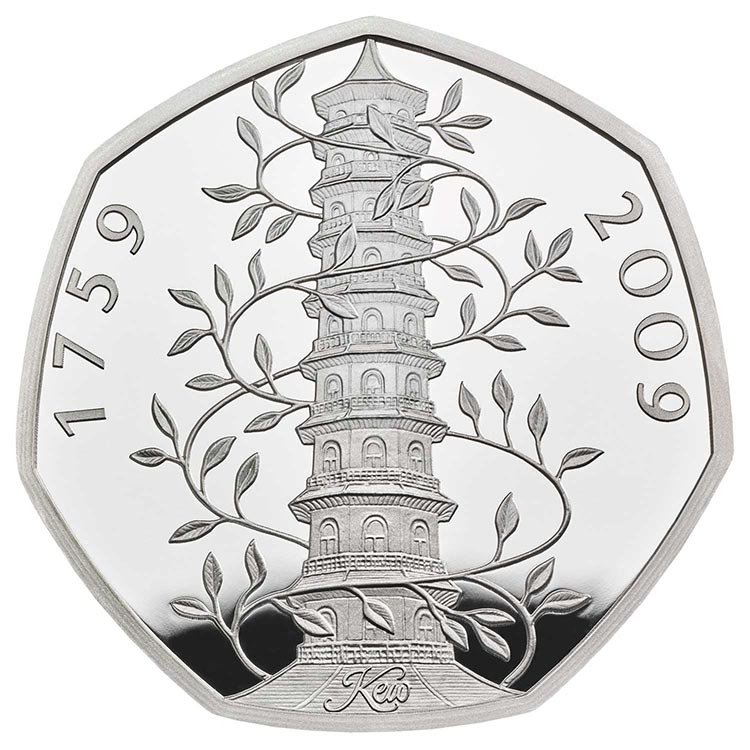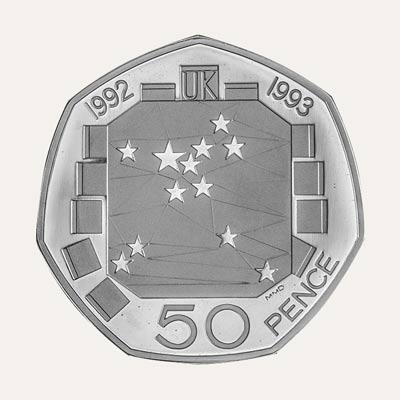50 years of the 50p
British Culture Set

Over the years the 50p has celebrated British achievements, events and milestones. The variety and quality of these commemorative designs have sparked something of a collecting craze. This hugely popular coin has captured the imagination of the entire country. More often than not it’s the gateway coin to starting a collection.
Decimalisation
The 50p entered circulation in readiness for the decimal switchover. Britain’s coinage system had remained unchanged for centuries but a number of Commonwealth countries such as Australia, New Zealand and South Africa had already gone decimal. The momentum was firmly for change and in 1966 parliament decided that Britain should follow suit. Within five years the nation’s ancient system of coinage would be consigned to the history books.
Under the old system there were 20 shillings in £1, 12 pennies in 1 shilling and 240 pennies in £1, making decimalisation a huge undertaking both in terms of production of new coins and the overarching publicity required. People were used to way things were and change never comes easy.
Information campaigns ran frequently to help avoid confusion. Leaflets were posted through letterboxes, posters were put up in windows and television broadcasts scheduled to explain the new system. The BBC broadcast a series of five-minute programmes known as Decimal Five, while on ITV an elderly woman was taught to use the new decimal system by her grandson in Granny Gets The Point.

Decimalisation
The 50p entered circulation in readiness for the decimal switchover. Britain’s coinage system had remained unchanged for centuries but a number of Commonwealth countries such as Australia, New Zealand and South Africa had already gone decimal. The momentum was firmly for change and in 1966 parliament decided that Britain should follow suit. Within five years the nation’s ancient system of coinage would be consigned to the history books.
Under the old system there were 20 shillings in £1, 12 pennies in 1 shilling and 240 pennies in £1, making decimalisation a huge undertaking both in terms of production of new coins and the overarching publicity required. People were used to way things were and change never comes easy.
Information campaigns ran frequently to help avoid confusion. Leaflets were posted through letterboxes, posters were put up in windows and television broadcasts scheduled to explain the new system. The BBC broadcast a series of five-minute programmes known as Decimal Five, while on ITV an elderly woman was taught to use the new decimal system by her grandson in Granny Gets The Point.


Meanwhile, the sheer volume of coins needed meant The Royal Mint had to move from Tower Hill to a production facility in South Wales. In 1968 the new site in Llantrisant was opened by Her Majesty The Queen and the copper coins required for the changeover went into production. The 5p and 10p coin entered circulation in April 1968. They corresponded in size and value to the old shillings and florins, making it easy to identify them as their ‘decimal twins’.
Released in 1969, the 50p was the world’s first seven-sided coin and replaced the 10-shilling note – amplifying the sense of change. With the new 50p, 10p and 5p in circulation that just left the three copper coins to come. They were introduced two years later in 1971, when the changeover to the new system went live.
Overseeing production of the 50p was Lord Fiske, chairman of the Decimal Currency Board. The choice of design was in stark contrast to the shape of the coin. But, this radical departure was no heptagonal novelty, rather it was designed to roll smoothly in vending machines.
Despite Christopher Ironside’s Britannia lending a sense of familiar, the new coin got off to a rocky start. Some people found it too similar to the new 10p. The British press had plenty to say on the subject – ’a monstrous piece of metal’ screamed one headline. A retired army colonel even started an Anti-Heptagonist movement but it was all a storm in a teacup and things quickly settled down. Retailers were won over by the coin’s cleanliness, a byproduct of its revolutionary design.

Despite Christopher Ironside’s Britannia lending a sense of familiar, the new coin got off to a rocky start. Some people found it too similar to the new 10p. The British press had plenty to say on the subject – ’a monstrous piece of metal’ screamed one headline. A retired army colonel even started an Anti-Heptagonist movement but it was all a storm in a teacup and things quickly settled down. Retailers were won over by the coin’s cleanliness, a byproduct of its revolutionary design.


The 50th Anniversary of the First Sub-Four-Minute Mile
Roger Bannister and his rival John Landy had both been threatening to break the four-minute mark for the mile. On 6 May 1954, the British medical student beat the Australian to the magic number. Conditions at the Iffley Road track in Oxford were far from ideal. Bannister nearly called off his attempt due to the gusting crosswinds but thankfully he changed his mind. Careful planning made a tilt at the record possible. Lead out by pacemakers Chris Brasher and Chris Chattaway, 200 metres from home, Bannister kicked for the line, taking the tape in 3 minutes 59.4 seconds. 3,000 jubilant spectators witnessed a piece of history in the making.
What was happening that year – 2004
The summer Olympics were held in Athens, the government announced plans to introduce university tuition fees, ten new countries joined the European Union, heads of state gathered to mark the 60th anniversary of D-Day and we said goodbye to Hollywood legend Marlon Brando who died aged 80
The 100th Anniversary of the Founding of the Scouting Movement
The scouting movement was founded in Britain in 1907 by Robert Baden-Powell, a cavalry officer. He hoped to instil in boys aged 11–14 a sense of resourcefulness and a code of chivalrous behaviour. To become a scout, a boy would promise to be loyal to his country, help others and obey the Scout law. Originally a British movement, Baden-Powell’s idea took off all over the world. Today there are scouting organisations in more than 170 different countries adhering to the famous motto, ‘be prepared’.
What was happening that year – 2007
The first total lunar eclipse in more than three years brought skywatchers out of their homes, Gordon Brown delivered his last budget as Chancellor of the Exchequer, the UK summer was one of the wettest on record and scientists discovered kryptonite – sadly it wasn’t green and glowing like in the Superman movies.

The 100th Anniversary of the Founding of the Scouting Movement
The scouting movement was founded in Britain in 1907 by Robert Baden-Powell, a cavalry officer. He hoped to instil in boys aged 11–14 a sense of resourcefulness and a code of chivalrous behaviour. To become a scout, a boy would promise to be loyal to his country, help others and obey the Scout law. Originally a British movement, Baden-Powell’s idea took off all over the world. Today there are scouting organisations in more than 170 different countries adhering to the famous motto, ‘be prepared’.
What was happening that year – 2007
The first total lunar eclipse in more than three years brought skywatchers out of their homes, Gordon Brown delivered his last budget as Chancellor of the Exchequer, the UK summer was one of the wettest on record and scientists discovered kryptonite – sadly it wasn’t green and glowing like in the Superman movies.


By 1910 Robert Baden-Powell’s scouting movement was taking off all over the world, so he asked his sister Agnes to start a similar group for girls. Through a mixture of fun, adventure and friendship the movement has inspired each new generation to face the challenging of growing up and to be the best they can be. The trefoil logo represents the threefold promise of the Guides – ‘I promise that I will do my best, to be true to myself and develop my beliefs, to serve the Queen and my community, to help other people and to keep the Guide Law.’
What was happening that year – 2010
Britain shivered in the longest cold snap for 30 years, Kathryn Bigelow become the first woman to win best director at the Oscars for The Hurt Locker, ash from a volcanic eruption in Iceland grounded flights for several days and the general election gave us a hung parliament, necessitating a Conservative-led coalition.

By 1910 Robert Baden-Powell’s scouting movement was taking off all over the world, so he asked his sister Agnes to start a similar group for girls. Through a mixture of fun, adventure and friendship the movement has inspired each new generation to face the challenging of growing up and to be the best they can be. The trefoil logo represents the threefold promise of the Guides – ‘I promise that I will do my best, to be true to myself and develop my beliefs, to serve the Queen and my community, to help other people and to keep the Guide Law.’
What was happening that year – 2010
Britain shivered in the longest cold snap for 30 years, Kathryn Bigelow become the first woman to win best director at the Oscars for The Hurt Locker, ash from a volcanic eruption in Iceland grounded flights for several days and the general election gave us a hung parliament, necessitating a Conservative-led coalition.
Just 210,000 Kew Gardens 50p coins were released into circulation, making it the rarest 50p design. Much hyped among the collecting community, the coin itself marked the 250th anniversary of the founding of this venerable institution, the country’s most famous royal botanical garden. The reverse design, created by Christopher Le Brun RA, features the famous Chinese Pagoda at Kew with a decorative leafy climber twining in and around the tower.
What was happening that year – 2009
Matt Smith was named as the new Doctor Who, the UK suffered its worst snowfall for 20 years and after an online campaign, Rage Against the Machine’s Killing in the Name beat X Factor winner Joe McElderry’s The Climb to the Christmas number one spot.


If you were to ask collectors which coin got them started, the chances are it was the 50p.
Over the years, the coin has been issued in a huge range of commemorative editions celebrating every aspect of British culture, from athletes to authors. The sheer variety has sparked a collecting craze but of all the 50p coins, the Kew Gardens 50p is arguably the most sought-after. Nothing gets people excited quite like this original 2009 design. Just 210,000 were released into circulation and with almost all of them in private hands, the chances of coming across one in your change are slim.
The venerable institution depicted on the Kew Gardens 50p coin is the nation’s most famous royal botanical garden. The reverse design, created by Christopher Le Brun RA, features the famous Chinese Pagoda at Kew with a decorative leafy climber twining in and around the tower. Demand for the 50p denomination was not high at the time of release into circulation which explains the low mintage of this particular design.
The Kew Gardens 50p is one of our most iconic and loved 50p coins and The Royal Mint has chosen to honour it by including it within our Celebrating 50 Years of the 50p 2019 British Culture Set
The issue of a 2019 year-dated Proof coin as part of the 50p celebration sets comes ten years after the initial launch of the Kew Gardens 50p and soon after a major renovation of the pagoda at Kew, restoring it to its former glory. Originally adorned by wooden dragons, these mythical beasts have returned to grace the tower once more. Britain’s first skyscraper looks set to see out another 250 years in style.
The 2019 version bears a different effigy of Her Majesty The Queen than the original 2009 version and of course, features the 2019 mintage date, but the Kew Gardens 50p design remains as iconic as ever. While this reissue gives collectors a chance to own a 2019-dated version of this sought-after design, it takes nothing away from the original circulating coin for anyone lucky enough to own one.

While the 2009 Kew Gardens coin is the most well-known and sought-after, there is actually another 50p with a lower mintage, pipping it to the title of rarest. Issued to mark the completion of the EU Free Trade Agreement, just 109,000 coins were struck. However, you won’t find one turning up in your change any time soon. One of the old-style, larger, heavier 50p coins, it was demonetised in 1998. So, the Kew Gardens coin can legitimately claim to be the rarest 50p currently in circulation.

© The Royal Mint Limited. The Royal Mint Limited whose registered office is at Llantrisant, Pontyclun, CF72 8YT, United Kingdom (registered in England and Wales No. 06964873).